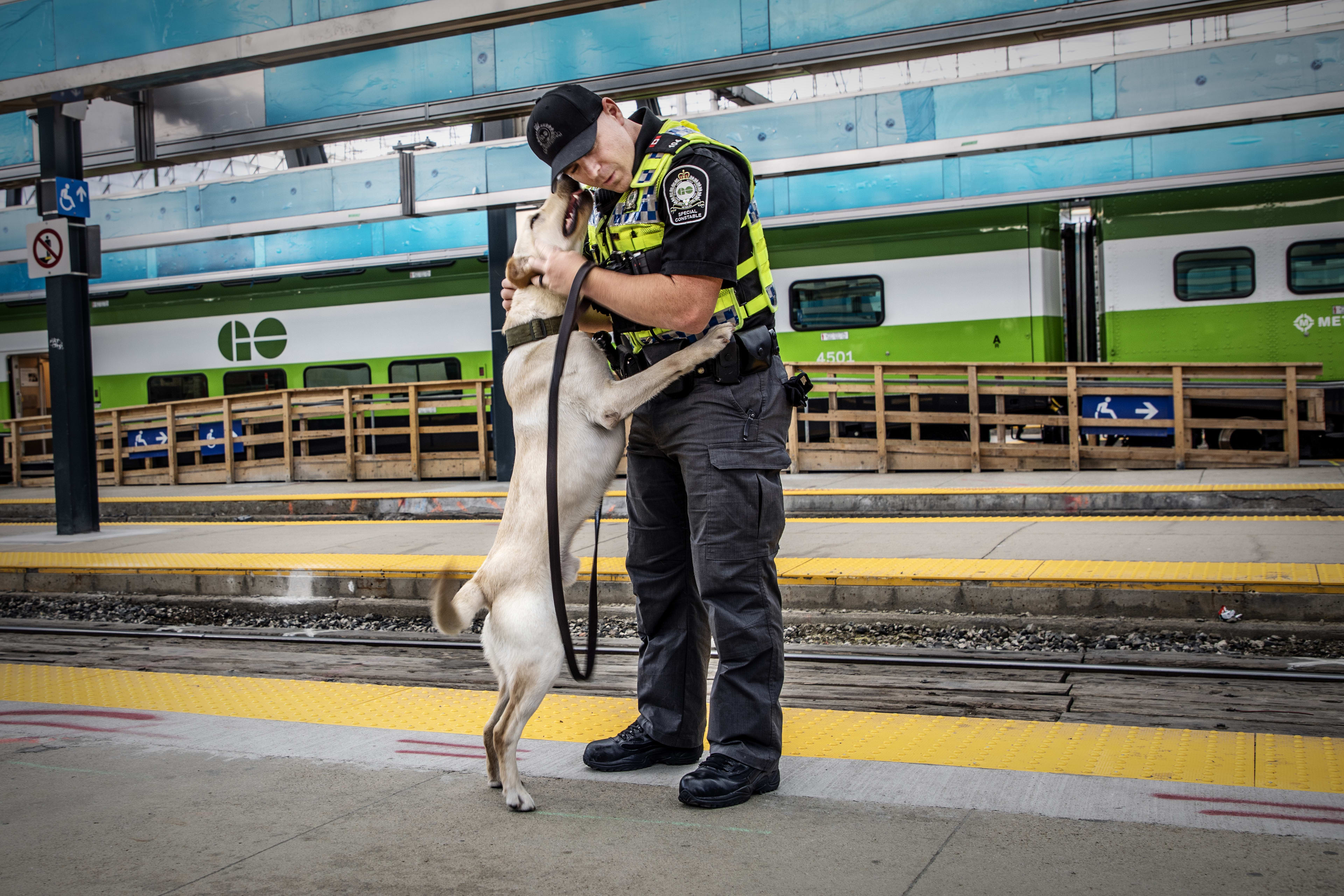Metrolinx Transit Safety teams expand to include K9 unit
The three newest team members are in training, and will be on duty sometime in September.
Aug 7, 2019
It’s a busy afternoon in York Concourse. Hundreds of thousands of people are flowing through Toronto’s Union Station, heading up to the GO Transit platforms.
But something seems out of place. There’s a grey duffle bag sitting against a pillar, unattended, in York Concourse. It immediately catches the eye of a Transit Safety Officer who investigates and decides what’s really needed, is the finely tuned nose of a K9 unit.
A package sits unattended in York Concourse during rush hour. Photo by Bill Grodzinski
Toronto Police Services detection dogs have been working behind the scenes at Union Station, Canada’s largest transit hub, keeping customers safe since 2013.
But now, a decision by Metrolinx to have its own teams on-call 24 hours a day, means officers can investigate suspicious objects in minutes – potentially saving GO Transit and UP Express customers hours in delays.
“We always encourage our customers to say something if they see something,” says Bill Grodzinski, director of transit safety. “Now with our new K9 officers, we can ensure public safety by investigating these incidents on our network much quicker.”
The dogs were carefully selected based on a combination of genetic and behavioural qualities.
While some breeds do tend to make better detection dogs than others, the breed isn’t necessarily the most important genetic factor. Having a keen nose on the other hand, is an absolute must. So is being in good health and passing a strict physical examination by a veterinarian.
The dog’s ability to respond to commands is also very important, and so too is its ‘hunt drive’. Essentially that means how long the dog will stay interested in searching for something. In this case, an ideal canine candidate is one that never gives up.
Another important factor when selecting a dog to help keep Metrolinx infrastructure, stations and customers safe, is how well the animal copes in large public spaces and how they react when they’re near noisy transit vehicles.
Transit Safety Officer Brenton Hoffman and his K9 partner Dash on the platform at Union Station. The teams’ sole function is dangerous material detection. They will continue to consult and work closely with Metrolinx’ police partners on when they should be called in. Photo by Matt Llewellyn
Following the rigorous selection process, the teams (handler and canine) receive specialized training from the Police Dog Services team at Toronto Police Service.
As part of that, the dogs spend time doing what you might call classroom work; learning the distinct odours associated with numerous dangerous materials. That skill is referred to as imprinting.
Officer Brenton Hoffman and Dash take a pause before starting another patrol. Photo by Matt llewellyn
The second major part of the police training process involves testing those imprinting skills in a real-world setting. That means hiding dangerous materials around a secret Toronto Police training facility and getting the handlers and dogs to sniff them out.
Transit Safety Officer Cindy Shigetomi and her K9 partner Raiden at an undisclosed Toronto Police training facility. The accredited 12-week training program prepares them for all of the challenges associated with keeping a larger transit network safe. Photo by Matt Llewellyn
“While we have a robust safety and security program in place, K9 teams are proven at deterring danger and enhancing safety,” says Sergeant Cam Cooper, Metrolinx transit safety training supervisor.
Cooper added, the three newest team members will be on duty sometime in September.
Unlike tracking dogs, which help apprehend suspects or narcotics dogs which help sniff out drugs, the Metrolinx K9 teams’ sole function is detection. Cooper adds the Metrolinx K9 unit will continue to consult and work closely with their police partners on when they should be called in.
Transit Safety Officer Cindy Shigetomi and her K9 partner Raiden at the UP Express terminal at Union Station. Photo by Matt Llewellyn
While the dogs are friendly, the Transit Safety team does ask customers to respect their space when they’re on duty.
“Of course there will be interest, it’s an animal,” says Cooper, adding: “it’s important to let our handlers do our jobs for your safety – and for the safety of the handlers as well.”
On their off hours, the dogs live with their handlers. While well cared for, they are not treated as casual family pets.
As for that lonesome grey bag, it turned out not to be a threat this time – with Toronto Police Service determining it had been filled, and forgotten, with hockey equipment.
Transit Safety Officer Brenton Hoffman and his K9 partner Dash on the platform at Union Station. Photo by Matt Llewellyn
Come September, it’ll be a new breed of Metrolinx officer who will answer the call when suspicions are raised and safety threatened.
by Matt Llewellyn Spokesperson
